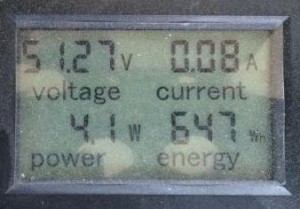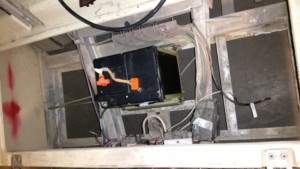This amounts to a bit of a side project, but provides a platform for really testing what the Volt lithium ion batteries are capable of. You can tell by the image above that I’m talking about putting lithium ion batteries, from a Chevy Volt, into a golf cart.
Why not just replace the lead acid batteries?
There are several reasons. The first is replacement cost–while this is a proof-of-concept, it can be done for about the same hardware cost as putting lead acid batteries in. These carts typically have 6 6 or 8-volt batteries (depending on whether it’s a 36V or 48V cart). Typical cost to replace the batteries is between $600 and $800. The Volt batteries, while used, can be had for about $100 per usable kWh. If we look at the lead acid batteries’ energy capacity to 50% depth of discharge, the standard configuration would be 3kWh of usable energy, or $200 per usable kWh. A single 2kWh Volt module is already 48V, so we could run on just one, at a cost of $250. But the goal is to make the electric carts go farther without charging on a golf cart, so we’ll install more than that.
Reason #2: Capital Cost and Replacement Frequency
Actually, the second reason is cost as well. But from a different standpoint. Typical lead acid batteries used on a golf course are only good for about 2 years. If you assumed year-round golf weather and no rainy days, that would be a little over 700 discharge cycles. The Volt battery should be capable of well more than that, and with proper management should be able to last 10 years or more. In most cases, that will mean that the batteries will get moved to a new cart when the rest of the cart has reached the end of its life.
In addition to faster charging, we also have the ability to increase the amount of energy on-board, making charging stops less frequent. Typically, on the course where the testing is going to happen, a cart is done for the day after two rounds of 18 holes. How much energy is that? We sent a cart out with a regular golfer with a monitor attached. After 9 holes, the cart had used about 0.65kWh, or 2.6kWh after 36 holes. That’s in keeping with the 3kWh expected of a new set of batteries. It also means that with 3.6kWh of lithium capacity, it’ll be an improvement over the status quo.

But 3.6kWh doesn’t quite make 3 rounds of 18–it would only be about halfway through the back 9 on the third round. We could install another module (bringing capacity to 5.4kWh and just over 4 18-hole rounds, for about $250 in batteries. We could also install rooftop solar for about the same price, and extend the range of the 2-module configuration. In two rounds, those panels should be able to pick up 1kWh pretty reliably most days, making for a solid 3 rounds. Anything more, and they’re reducing charge time and cost.
Reason #3: Charging Cost
It might come as no surprise that the third reason is cost also–from a charging standpoint. The lithium batteries should be more efficient in charging, and can do so much faster. Faster charging means fewer charging stations are needed, and a cart might even be able to return for another round after a mid-day charge. Getting an extra round out of a cart without an overnight charge means a course needs fewer carts, which of course saves money.
Now, with fewer carts, other things may wear out sooner (in time). Carts get banged up on the course–whether it’s running rough in search of a lost ball, bumping into things, wear and tear from spikes on the floor mat or tees on the upholstery, they don’t last forever. At least some of the mechanical wear is reduced though, as the cart is lighter than before. Each 2kWh section is about 42lbs–so we’ll have 84 lbs of battery taking the place of almost 400. That means that the cart ready to roll has shed 1/3 of its weight, not counting passengers and cargo, which should help the life of at least some of those components.
How easy is it to do?
Simply replacing the source of power is really easy. Take out all of the boat anchors, and connect the power leads to the 42lb module, and the cart will run. In a Club Car DS with a separately excited motor and electronic controller, here’s the result:
Ok, so I was kind of cheating–with the electronic controller there’s a pre-defined ramp-up in power when you floor it. I was holding the brake during the ramp period so that I got off the line quicker. In an older Club Car cart, with a series motor and no electronics, it’s simply how fast you step on it that matters.
Getting a quick launch is actually a lot easier that way, but also becomes something that we don’t want out tearing up the course. Not everyone is going to practice a quick launch with a brake hold; it’s far more likely that someone will just stomp on the pedal. More on that later.

But it looks a little lonely without company. To protect the pack from overcharging or over-discharging, we need a controller and new charging system. That’s a little more sophisticated, as it’s something that doesn’t exist off-the-shelf. But since we’re going to the trouble, there are a few other things that can be done at the same time:
- Charge/discharge control–turn the charger on and off at the right times and disable the cart from moving if the battery is depleted.
- Solar charging–control power from 240W of solar mounted on the roof going into the batteries. Simply turn off controller at night to eliminate need for blocking diodes.
- Temperature monitoring–detect problems, and prevent use in temperature extremes.
- Data logging–this is a big one. We hope to learn a lot about how these batteries really work. With a fleet of carts, this should prove invaluable.
- Simplified cell balance monitoring–we’re not going to automate balancing, but we will keep an eye on it.
- Remote shutdown–should course staff see someone starting to do something they shouldn’t, the cart can be turned off remotely until someone goes out to address the problem in person.
- Geofencing–carts aren’t allowed on the greens or on tee boxes. Geofencing means that the cart can be disabled or sound an alarm if someone tries driving in one of these areas.
- Anti-theft–should someone try to steal a cart, it will lose its connection to the course’s wireless network. It’ll sound a Hollywood-style bomb countdown, then self-destruct. No, not really (or maybe it will–don’t steal golf carts!) Seriously, it’ll be set to stop working if it can’t phone home for a couple of days–long enough that intermittent connection problems don’t interrupt play.
That all probably sounds complicated, but there’s a lot of overlap with the house battery system that’s been installed since February. The whole system should be ready for testing on the golf course within a week. Here’s one more video, showing the cart tooling around with the solar panels working.
I’ll follow up on more of the controls, wiring, and the rest before long.